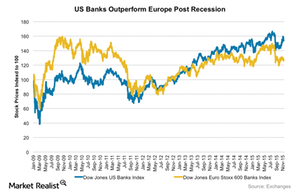US Banks Played a Pivotal Role in the 2008 Financial Crisis
During the period between September 2008 and March 2009, US stock markets plunged, and the financial sector fell 60% in value.
Nov. 17 2015, Updated 11:01 a.m. ET

Regulations and recovery
Large US banks were at the epicenter of the financial crisis of 2008. During the period between September 2008 and March 2009, US stock markets represented by the S&P 500 SPDR ETF (SPY) plunged nearly 50%, while the financial sector, represented by the Financial Sector SPDR ETF (XLF), fell ~60% in value.
Since then, however, US markets have recovered better than the Eurozone. SPY has soared 168%, while the SPDR EURO STOXX 50 (or FEZ) has gained merely 40% as of November 16, 2015. Much of the underperformance of European stock markets is attributable to weaker regulations compared to the United States as well as to the sovereign debt crisis that struck in 2011.
Stocks that have partly fueled the rally in the United States include those from banks such as JPMorgan Chase (JPM), Wells Fargo (WFC), Bank of America (BAC), and Citigroup (C).
Factors that fueled the fire
More specifically, the 2008 crisis, which was fueled by the housing boom in the United States, was ignited by an unregulated shadow banking system that was growing out of proportion and overtaking the traditional banking sector in size. Most of these institutions did not fall under the supervision of the Federal Reserve at the time.
At the peak of the crisis, many large financial institutions failed to manage their risks. As a result, investors and creditors lost trust in these institutions and had concerns over their liquidity and ability to meet short-term liabilities.
Consequently, some of these institutions became increasingly reliant on short-term borrowing at near-zero interest rates to fund their lending and operations, which generated high returns.
As a result, as we know, the Federal Reserve had to step in to bring about stringent regulations. But what exactly were these regulations? Continue to the next part of this series to find out.
Correction: This article originally misstated the amount SPY fell in March 2009. We regret this error.
